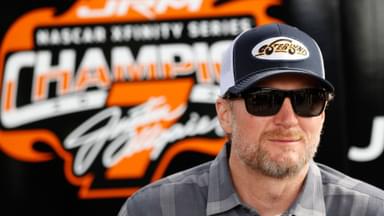Chevrolet has officially pulled the wraps off its revamped Camaro ZL1 for the 2026 NASCAR Cup Series season, revealing a sleeker, more aerodynamic body that will hit the track next year. The subtle redesign borrows cues from a recently released performance accessories kit for the production Camaro. But while fans celebrated the reveal, one particular Chevrolet loyalist, Dale Earnhardt Jr., found himself torn between excitement and unease.
Advertisement
The JR Motorsports co-owner, who plans to field his team once again in the 2026 Daytona 500, admitted the announcement has him on edge. His concern isn’t about resources or preparation; it’s about the unknowns that come with a brand-new car body.
NEWS: @TeamChevy will hit the racetrack for the 2026 NASCAR Cup Series campaign, sporting an updated design of its Chevrolet Camaro ZL1 — aligned with the automaker's recently released Camaro ZL1 Carbon Performance Package#NASCAR pic.twitter.com/SFQXwUB15a
— Joseph Srigley (@joe_srigley) November 14, 2025
When JRM made its Cup debut at the tri ocal in warlier this year, Justin Allgaier took the wheel of the No. 40 Chevy and drove it to an impressive top-10 finish. With the team preparing for another entry, Dale Jr. views the timing as ideal from a financial standpoint, the perfect window to run without losing money. However, the unpredictability of a new body design is giving him pause.
As he put it, “I’m nervous because we’re going to have a new body. Anytime a manufacturer gets a new body, they don’t go to Daytona and perform better. You’re figuring out kind of what makes that body perform at a track like that. I don’t know details, I just shoot it straight.”
Historically, when a manufacturer introduces a fresh body design, teams spend the early races playing catch-up, deciphering how it behaves under pressure. The challenges will go beyond horsepower and handling, including unlocking the sweet spot where aerodynamics meet balance.
Manufacturers also tend to focus on optimizing the new body for the sport’s most visited tracks, which are intermediates, hence Junior’s apprehension. Instead of banking on upgrades, he prefers stability, the same formula that earned JRM success last time out.
If it were up to him, everything would remain unchanged: the same car, same crew, same people. Allgaier would once again take the reins, Greg Ives would call the shots as crew chief, and Barry Hoover would stand beside Junior in the pit box.
In a sport where variables can flip a race on its head, Dale Jr. knows continuity is gold. He doesn’t intend to fix what isn’t broken. So, while Chevrolet fine-tunes its next-generation body for Daytona’s high banks, Dale Jr.’s focus remains grounded in what’s already worked. It now remains to be seen how the new body affects his team’s performance come the season opener.







